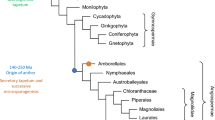Abstract
Anther form and structure across the taxonomic groups inVerticordia were examined. The three anther types which were recognised — rectangular, oblong and saccate, accord well with the three subgenera into which the genus has been divided. The sporogenous part of the anther has a fairly typical angiosperm anatomy. However in many species there is a small or large gland in the upper filament/connective which contains lipidic contents. The anatomy of this structure is based on that of the oil glands which are ubiquitous in Myrtaceae primary tissues. However the gland is usually much larger than these and is schizolysigenous in origin. Evolutionary development of the anthers in the genus is related to pollination systems and the development of secondary pollen presentation from the upper style in some groups. Anther glands may have originally had a protective function for the sporogenous tissue. However in different groups the function has changed or the gland has disappeared. In some species in subgenusChrysoma (which does not have secondary pollen presentation) the gland contents seem to be an additional food source for pollinators. In other groups, with the development of secondary pollen presentation the protective function has become redundant and anther glands have either disappeared or produce contents which have become part of the process of pollen dispersal.
Similar content being viewed by others
References
Armbruster W. S., Howard J. J., Clausen T. P., Debevec E. M., Loquvam J. C., Matsuki M., Cerendolo B., Andel F. (1997) Do biochemical exaptations link evolution of plant defence and pollination systems? Historical hypotheses and experimental tests withDalechampia vines. Am. Nat. 149: 461–484.
Beardsell D. V., Williams E. G., Knox R. B. (1989) The structure and histochemistry of the nectary and anther sectretory tissue of the flowers ofThryptomene calycina (Lindl.) Stapf (Myrtaceae). Aust. J. Bot. 37: 65–80.
Bentham G. (1867) Flora Australiensis, Vol 3. L. Reeve & Co, London.
Brown E. M., Burbidge A. H., Dell J., Edinger D., Hopper S. D., Wills R. T. (1997) Pollination in Western Australia: A database of animals visiting flowers. Handbook No. 15, WA Naturalists' Club, Perth.
Bussell B. M., Considine J. A., Spadek Z. E. (1995) Flower and volatile oil ontogeny inBoronia megastigma. Ann. Bot. 76: 475–463.
Carr S. G. M., Carr D. J. (1970) Oil glands and ducts inEucalyptus L'Herit. 3. Development and structure of oil glands in the embryo. Aust. J. Bot. 18: 191–212.
D'Arcy W. G. (1996) Anthers and stamens and what they do. In: D'Arcy W. G., Keating R. C. (eds.) The anther. Cambridge University Press, Cambridge, pp. 1–24.
Endress P. K. (1994) Shapes, sizes and evolutionary trends in stamens of the Magnoliidae. Bot. Jahrb. Syst. 115: 429–460.
George A. S. (1991) New taxa, combinations and typifications inVerticordia (Myrtaceae: Chamelaucieae). Nuytsia 7: 321–394.
Green J. W. (1980) A revised terminology for the spore-containing parts of anthers. New Phytol. 84: 401–406.
Heslop-Harrison J. (1968) Tapetal origin of pollencoat substances inLilium. New Phytol. 67: 779–786.
Holm E. (1988) On pollination and pollinators in Western Australia. Eigil Holm, Gedved.
Houston T. F., Lamont B. B., Radford S., Errington S. G. (1993) Apparent mutualism betweenVerticordia nitens andV. aurea (Myrtaceae) and their oil-ingesting bee pollinators (Hymenoptera: Colletidae). Aust. J. Bot. 41: 369–380.
Hufford L. (1996) The origin and early evolution of angiosperm stamens. In: D'Arcy W. G., Keating R. C. (eds.) The anther. Cambridge University Press, Cambridge, pp. 58–91.
Johnson L. A. S., Briggs B. G. (1984) Mytrales and Myrtaceae — a phylogenetic analysis. Ann. Miss. Bot. Gard. 71: 700–756.
Knox R. B. (1984) The pollen grain. In: Johri B. M. (ed.) Embryology of Angiosperms. Springer, Berlin, pp. 197–271.
Ladd P. G. (1994) Pollen presenters in the flowering plants — form and function. Bot. J. Lin. Soc. 115: 165–195.
List S., Brown P. H., Walsh K. B. (1996) Functional anatomy of the oil glands ofMelaleuca alternifolia (Myrtaceae). Aust. J. Bot. 43: 629–641.
Lucknow M., Grimes J. (1997) A survey of anther glands in the mimosoid legume tribes Parkieae and Mimoseae. Am. J. Bot. 84: 285–297.
Manning J. C. (1996) Diversity of endothecial patterns in the angiosperms. In: D'Arcy W. G., Keating R. C. (eds.) The anther. Cambridge University Press, Cambridge, pp. 136–158.
O'Brien S. P. (1996) Timetable of stigmatic receptivity and development and pollen tube growth inChamelaucium uncinatum (Myrtaceae). Aust. J. Bot. 44: 649–659.
Prakash N. (1969) Reproductive development in two species ofDarwinia Rudge (Myrtaceae). Aust. J. Bot. 17: 215–227.
Richardson K. C., Jarret L., Finke E. H. (1960) Embedding in epoxy resin for ultrathin sectioning in electron microscopy. Stain Technology 35: 313–323.
Schmid R. (1976) Filament histology and anther dehiscence. Bot. J. Linn. Soc. 73: 303–315.
Slater A. T., Beardsell D. V. (1991) Secondary pollen presentation in the Chamelaucium alliance of the Myrtaceae: a compact substigmatic ring inChamelaucium. Aust. J. Bot. 39: 229–260.
Tyagi A., Considine J., McComb J. (1992) Germination ofVerticordia pollen after storage at different temperatures. Aust. J. Bot. 40: 151–155.
Westerkamp C. (1997) Flowers and bees are competitors — not partners. Towards a new understanding of complexity in specialised bee flowers. Proc Int'l Symp. on Pollination. Richards K. W. (ed.) Acta Hort 437: 71–74.
Author information
Authors and Affiliations
Rights and permissions
About this article
Cite this article
Ladd, P.G., Parnell, J.A.N. & Thomson, G. Anther diversity and function inVerticordia DC. (Myrtaceae). Pl Syst Evol 219, 79–97 (1999). https://doi.org/10.1007/BF01090301
Received:
Accepted:
Issue Date:
DOI: https://doi.org/10.1007/BF01090301




